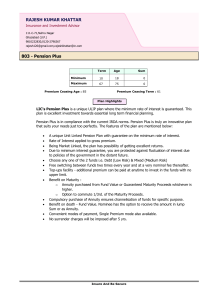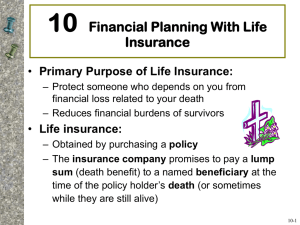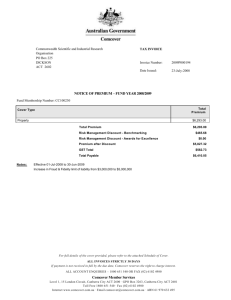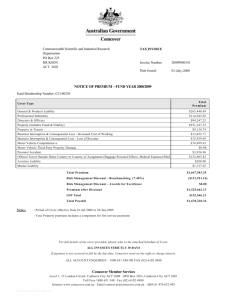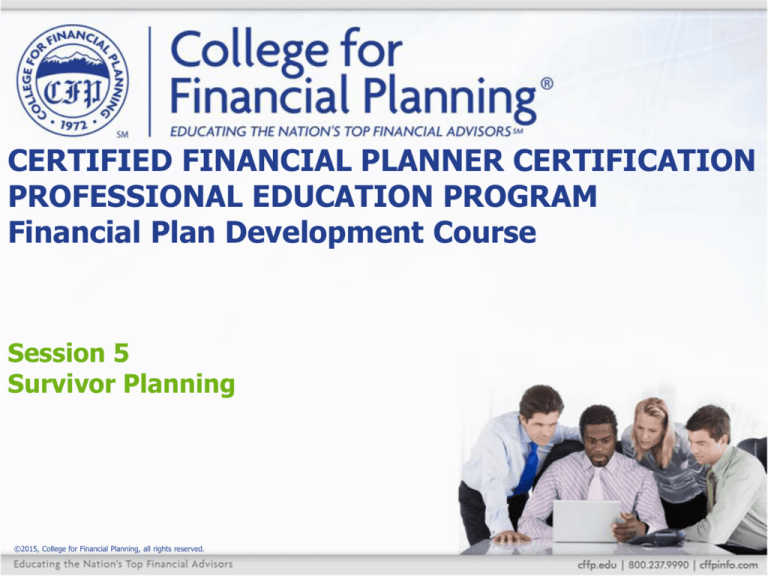
CERTIFIED FINANCIAL PLANNER CERTIFICATION
PROFESSIONAL EDUCATION PROGRAM
Financial Plan Development Course
Session 5
Survivor Planning
©2015, College for Financial Planning, all rights reserved.
Start Recording
This class is being
recorded so you may
review it at a future
time.
5-2
Life Insurance Analysis
Planner’s Job
• Explore “what if”
• Show client how to protect from devastating
risks
• Disability and/or death are devastating and
common. Look at these statistics*:
*from Social Security Administration mortality tables
5-3
How much life insurance?
5 common methods of
determining gross life
insurance needs:
• Needs-based analysis*
• Human life value
• Capital retention
• Income replacement
• Simple income multiplier
approach
*CFP Board position is that thumbnail approaches are
inappropriate – planners use needs-based analysis.
5-4
Your Clients
• Your clients’ assumptions and goals
• Is this enough to complete your analysis?
5-5
What coverage do they have now?
• When should they
•
•
replace whole life?
What is Belth formula?
What are your options
for current coverage?
5-6
What do clients need?
You must consider:
• Immediate cash needs
•
•
(debts, mortgage, immediate cash)
Funding goals of cabin and college
($139,773 identified in future class)
Total cash immediately
$261,997
$100,000+
$501,770
Even if there were no income
support needs, Anne now
has just $107,000.
• income needs
• tax bracket
5-7
Sample Budget in Case of Death
• How good were you at
•
•
predicting your budget
today 10 years ago?
Seems reasonable at
first
Clients and planners
are good at figuring
out what expenses
may disappear, such
as paying off
mortgage.
5-8
Think it Through
•
•
•
•
Consider what may
increase over 50 years
besides inflation!
What budget will make you
happy to see the
widower/widow walk
through your door?
What budget would make
you want to hide under the
desk?
You are projecting over 50
years! What new
expenses/changes will
occur in 50 years that you
need to anticipate?
5-9
Your Clients’ Life Analysis
5-10
Life Insurance Analysis
• Analysis shows Jim and Matt would be short
•
•
approximately $400,000 if Anne dies.
If Jim dies, Anne and Matt have an additional
coverage need of $929,489 that you can
predict.
There are price breaks at $1,000,000.
• What other issues exist?
• How long will coverage be needed?
Why use Jim and Matt, and not just Jim?
5-11
Sample Options
Not for your clients! Remember that you have to do your own.
Option 1: Purchase new 20-year term policy for $1,500,000. This will
cost approximately $1,650 per year level premium, which is higher than
your current coverage (i.e., $852) by $798.
Advantages
• Need is covered until you retire – even if unemployed
• Premium will stay level
Disadvantages
• Higher current premium for two years more than needed
• May be more insurance than you need in later years
• No coverage after age 62 and will most likely be unable to
purchase at that time
• If things go wrong, the insurance level may not be adequate
5-12
More Options
Option 2: Purchase a new 20-year term policy for $1,000,000 and a
$500,000 10-year term policy, which is higher than your current
coverage (i.e., $852) by $588 per year.
Advantages
• Premium will be level and full need is covered.
• In 10 years, if things go according to plan: college funding
completed ($135,000), debts paid off ($48,341), Autumn’s car paid
off ($20,000), emergency reserve built ($41,500), and 10 years of
supplemental income of $30,000 per year will be gone ($296,000),
for a total of $540,841, leaving a gap of $40,841 in coverage.
Disadvantages
• If things do not go according to plan, you may need more than
$1,000,000 of coverage in 10 years.
• You will be spending $588 more per year.
• You will have no coverage after age 67.
5-13
More Options
Option 3: Purchase a $1,000,000 term policy for 20 years, $400,000
10-year term, and a $100,000 permanent policy for total premium of
$1,772, which is $920 more than current.
Advantages
• You would have a policy that would continue into retirement.
• Allow you to leave an inheritance.
Disadvantages
• Your current cash flow would make this difficult to support
while funding college.
• If things go wrong, you may be unable to keep up premiums
and lose money you invested to create.
• Front-end loads
5-14
Policy Cost Considerations
• Term policies compared on basis of premium dollar per
•
•
•
•
•
$1,000 for similar face amounts
Pay attention to details and riders (i.e., waiver of
premium, ability to extend coverage, future rate
guarantees)
There are breakpoints impacting cost, so compare
similar face amount and terms
Can be level or yearly renewable
Rating of company also a
consideration
Do due diligence on policies
you sell and policies clients own
(you can be liable for both)
5-15
Cash Value Policies
• Company strength and reliability more important since it
•
•
•
•
could span 40 years!
Yearly price per thousand (YPPT Formula – also known
as Belth formula) is effective in determining cost per
thousand paid for a policy
Information available by underwriting company upon
diligent requests
Understand assumptions
driving illustrations
Review and document
yearly
5-16
Important Considerations
•
•
•
•
Never cancel an existing policy until
a new one is completely in place
with premium drafting
Churning policies, lack of due
diligence on companies, failure to
illustrate policies with reduced
returns, or unrealistic returns create
lawsuits
Always consider nonforfeiture
provisions for managing premiums
and death benefits before dropping
or eliminating coverage
Consider 1035 exchanges into
annuity or long-term care if
insurance not needed or if you don’t
want permanent
5-17
Nonforfeiture Provisions & Other Alternatives
When premium becomes an issue or insurance needs
change, owners of cash value life insurance policies can
employ these techniques:
• Purchase paid-up coverage (reduce face amount)
• Purchase fully paid term insurance (keep face amount or lower
amount for specific number of years)
• Use loans to pay premiums
• Use dividends to pay part or all of premium and/or repay loans
• Have dividends buy additional insurance—term or paid up
• Withdraw dividends from “dividends on
deposit” for other purposes
• Utilize loan to pay off high
interest debt and establish
repayment plan
5-18
1035 Exchanges
Tax code allows certain exchanges for insurance on a
tax-free basis (important consideration on cash value policies)
• A currently owned policy for a newly issued policy – cash
value life to cash value life
• Endowment contract for another endowment or annuity
contract
• Currently owned policy for annuity contract
• Annuity contract for another
annuity contract
• Annuity or life insurance for a
long-term care contract
5-19
Cash Value vs. Term
•
Goal of policy: Temporary or permanent need
o Under 10 years—temporary
o Between 10–20 years?
o Over 20—permanent
•
Health status or lifestyle, family history issues
o May want to consider permanent if family history
or habits indicates rating or uninsurability in future
•
Forced savings component
o Permanent with plan to convert to annuity or long-term
care can work for people who always pay bills but
don’t always save
•
•
High tax bracket individuals making max contributions to
qualified plans
o Tax-advantaged accumulation can be appealing
(watch out for termination of policy taxation)
Cash flow constraints can dictate type of policy
•
Do your own comparisons so you understand!
5-20
Pick Your Recommendation & Analyze Impact on Other Areas
Life insurance can impact:
• Cash flow
• Disability if waiver of premium added
• Can be tied with Social Security starting date
• College funding
• Estate planning
• Future income needs
in case of disability or
death so survivor
can continue
payments
5-21
Plan Development #11
You were given the amount of insurance needed based on
the goals provided, the choices for his permanent coverage
and the costs of various options.
Do you have questions about what you are to do?
You decide whether to stay with analysis or shift it slightly
with reasons. You pick the type of insurance and build your
recommendation with the reasons that led you to your
choice.
5-22
Help Clients Own the Problem
You have done the analysis and figured out the solution. You went
through the process to identify the issue and the consequences of
addressing the issue.
Did you lead the client through the process in the initial stages?
If not, how are you going to lead them through the process? When are
you going to lead them through this process?
In this class, you partially
led them through the process
in your executive summary
issue statement. In real life,
if it is the first time they see
it, they will not act!
If clients can’t tell you consequences
of not addressing issue, they don’t
own or understand the issue.
5-23
Include Enough Details
Clearly paint the picture of what happens now and in the future if a death occurs with
the current financial situation.
Use present value numbers or talk in terms of percentages of current budget cut.
Get confirmation from the client about their desired lifestyle and what it would be like
without the desired lifestyle. Have the client describe the financial impacts and what
would happen (move, change schools, no college, etc.) without the life insurance.
Discuss what percentage the premium represents of today’s lifestyle compared to the
percentage reduction in lifestyle if one dies. Which cut is easier to make?
Ask client confirmation questions about benefits
and drawbacks to strategy.
Lead discussion on alternative
recommendations and get client to
focus on characteristics of disadvantages
and advantages that are key to
making a decision.
5-24
Next Class
Prior to next class
Read Long-Term
Care
Time will be spent
on topics beneficial
to your
comprehensive plan
and real-world
clients.
Health care is next,
then behavioral
economics to use in
your
recommendations.
Catch up, refine your
current plans and
cash flow.
Complete box #12
5-25
CERTIFIED FINANCIAL PLANNER CERTIFICATION
PROFESSIONAL EDUCATION PROGRAM
Financial Plan Development Course
Session 5
End of Slides
©2015, College for Financial Planning, all rights reserved.

